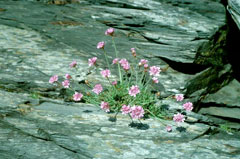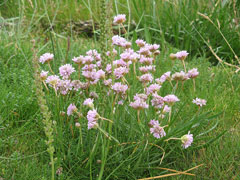 |
|
(c) 2010 Ken Fern & Plants For A Future |
 |
| ttp://commons.wikimedia.org/wiki/User:Southgeist |
Translate this page:
Summary
Bloom Color: Pink, Purple, Red, White. Main Bloom Time: Early summer, Late spring, Mid summer. Form: Upright or erect.
Physical Characteristics

 Armeria maritima is an evergreen Perennial growing to 0.1 m (0ft 4in) by 0.2 m (0ft 8in) at a slow rate.
Armeria maritima is an evergreen Perennial growing to 0.1 m (0ft 4in) by 0.2 m (0ft 8in) at a slow rate.
See above for USDA hardiness. It is hardy to UK zone 4 and is not frost tender. It is in leaf all year, in flower from June to August. The species is hermaphrodite (has both male and female organs) and is pollinated by Bees, flies, beetles, Lepidoptera (Moths & Butterflies).
It is noted for attracting wildlife.
Suitable for: light (sandy) and medium (loamy) soils, prefers well-drained soil and can grow in nutritionally poor soil. Suitable pH: mildly acid, neutral and basic (mildly alkaline) soils and can grow in saline soils.
It cannot grow in the shade. It prefers dry or moist soil and can tolerate drought. The plant can tolerate maritime exposure.
UK Hardiness Map
US Hardiness Map
Synonyms
A. elongata. A. vulgaris. Statice armeria. S. maritima.
Plant Habitats
Ground Cover; Cultivated Beds; East Wall. In. South Wall. In. West Wall. In.
Edible Uses
Edible Parts: Leaves Root
Edible Uses:
Leaves - cooked[177]. Used for slimming[61]. Root[69]. No more details are given[69].
References More on Edible Uses
Medicinal Uses
Plants For A Future can not take any responsibility for any adverse effects from the use of plants. Always seek advice from a professional before using a plant medicinally.
Urinary
Sea thrift is rarely used in herbal medicine, though the dried flowering plant is antibiotic and has been used in the treatment of obesity, some nervous disorders and urinary infections[268]. It cannot be used externally as an antibiotic poultice because it can cause dermatitis or local irritation[268].
References More on Medicinal Uses
The Bookshop: Edible Plant Books
Our Latest books on Perennial Plants For Food Forests and Permaculture Gardens in paperback or digital formats.

Edible Tropical Plants
Food Forest Plants for Hotter Conditions: 250+ Plants For Tropical Food Forests & Permaculture Gardens.
More

Edible Temperate Plants
Plants for Your Food Forest: 500 Plants for Temperate Food Forests & Permaculture Gardens.
More

More Books
PFAF have eight books available in paperback and digital formats. Browse the shop for more information.
Shop Now
Other Uses
A good ground-cover for a sunny position[200]. The cultivar 'Vindictive' has been especially recommended[188] and so has 'Alba'[190]. Plants form a slowly spreading carpet[208].
Special Uses
Attracts Wildlife Ground cover
References More on Other Uses
Cultivation details
Landscape Uses:Alpine garden, Border, Container, Massing, Rock garden, Seashore, Specimen. Succeeds in most soils including clay and poor sands[200]. Prefers a well-drained sandy soil with added leaf mould and a sunny position[1, 111, 134]. Requires an acid soil according to one report[24] whilst others say that it dislikes acid soils. Plants are very wind-tolerant and succeed in maritime gardens[233]. Established plants are drought tolerant[190]. Succeeds when grown at the top of a retaining wall or a cavity wall[219]. The plant tolerates light treading[200]. It forms a slowly expanding clump and makes a good edging plant[111]. A good butterfly plant[24, 30]. The flower is a symbol of sympathy, used at funerals[66]. Special Features:
North American native, Suitable for cut flowers.
References Carbon Farming Information and Carbon Sequestration Information
Temperature Converter
Type a value in the Celsius field to convert the value to Fahrenheit:
Fahrenheit:
The PFAF Bookshop
Plants For A Future have a number of books available in paperback and digital form. Book titles include Edible Plants, Edible Perennials, Edible Trees,Edible Shrubs, Woodland Gardening, and Temperate Food Forest Plants. Our new book is Food Forest Plants For Hotter Conditions (Tropical and Sub-Tropical).
Shop Now
Plant Propagation
Seed - pre-soak for 8 hours in warm water and then sow in pots of sandy soil in a cold frame. Germination usually takes place in 2 - 3 weeks at 15°c[134]. When large enough to handle, prick the seedlings out into individual pots and grow them on in a cold frame for their first winter, planting them out in late spring or early summer. Division in spring or after flowering[111]. Fairly easy, large divisions can be planted out straight into their permanent positions whilst it is probably best to pot up smaller divisions and to grow them on in light shade in a cold frame until they are rooting well.
Other Names
If available other names are mentioned here
Native Range
TEMPERATE ASIA: Turkey, Russian Federation-Eastern Siberia (Eastern Siberia), Russian Federation (Buryatia, Yakutia-Sakha, Krasnoyarsk, Tyumen), Mongolia, Russian Federation (Kamcatskij kraj, Magadanskaja oblast, Sakhalin) NORTHERN AMERICA: Canada (Northwest Territories, Yukon, Québec, Ontario, Newfoundland and Labrador, Saskatchewan, Alberta, Manitoba, British Columbia), Greenland, United States (Alaska, Oregon (west), Washington (west), California (west)) SOUTHERN AMERICA: Argentina (south), Chile (c. & s.) EUROPE: Denmark, Finland, Faroe Islands, United Kingdom, Ireland, Iceland, Norway, Sweden, Austria, Belgium, Switzerland, Czech Republic, Germany, Hungary, Poland, Slovakia, Russian Federation (European part), Belarus, Estonia, Lithuania, Latvia, Ukraine, Montenegro, Romania, Serbia, Spain, France, Portugal
Weed Potential
Right plant wrong place. We are currently updating this section.
Please note that a plant may be invasive in one area but may not in your area so it's worth checking.
Conservation Status
IUCN Red List of Threatened Plants Status :

Growth: S = slow M = medium F = fast. Soil: L = light (sandy) M = medium H = heavy (clay). pH: A = acid N = neutral B = basic (alkaline). Shade: F = full shade S = semi-shade N = no shade. Moisture: D = dry M = Moist We = wet Wa = water.
Now available:
Food Forest Plants for Mediterranean Conditions
350+ Perennial Plants For Mediterranean and Drier Food Forests and Permaculture Gardens.
[Paperback and eBook]
This is the third in Plants For A Future's series of plant guides for food forests tailored to
specific climate zones. Following volumes on temperate and tropical ecosystems, this book focuses
on species suited to Mediterranean conditions—regions with hot, dry summers and cool, wet winters,
often facing the added challenge of climate change.
Read More
Expert comment
Author
(Mill.)Willd.
Botanical References
17200
Links / References
For a list of references used on this page please go here
Readers comment
© 2010, Plants For A Future. Plants For A Future is a charitable company limited by guarantee, registered in England and Wales. Charity No. 1057719, Company No. 3204567.